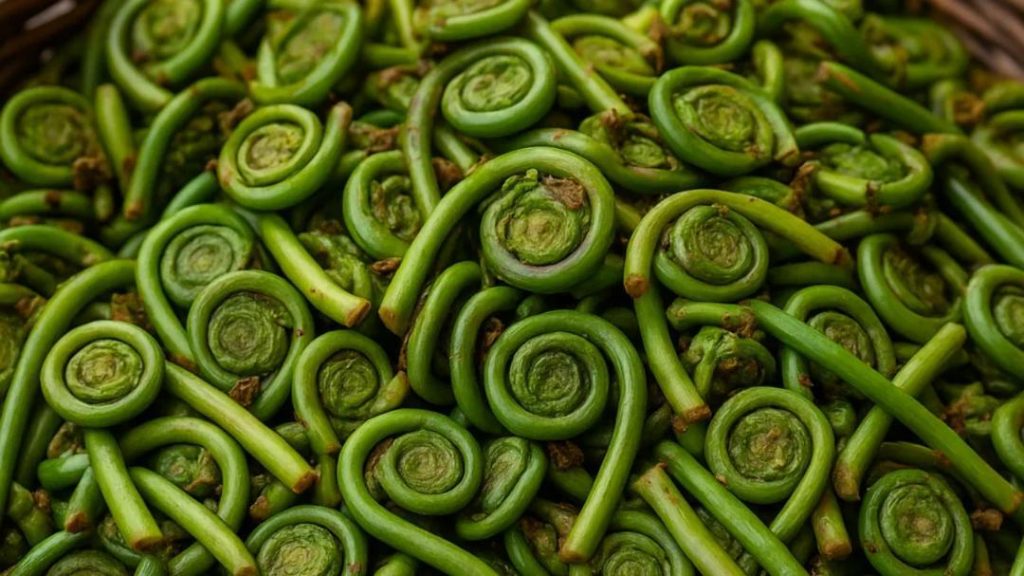
Lingad, a Monsoon Fern, Boosts Immunity and Bone Health
As the monsoon rains bring life to the parched earth, the Himalayas come alive with a treasure trove of edible delights. One of the most sought-after and nutritious foraged delicacies is the Lingad, also known as the fiddlehead fern. This young, coiled shoot is a staple in many Himalayan regions, where it’s harvested when tender and curled, before it matures and becomes fibrous and unfit for cooking. Rich in unique flavors and steeped in tradition, Lingad is not only a culinary delight but also a treasure trove of health benefits.
What is Lingad?
Lingad, scientifically known as Diplazium esculentum, is a type of fern that grows in the Himalayas, particularly during the monsoon season. It’s locally known by various names, including Lengdu, Dhekia, and Nigro, depending on the region. The fern’s young, curled shoots are the most prized part, as they contain higher concentrations of nutrients and flavor compounds.
Nutritional Profile
Lingad is a densely nutrient-rich food, packed with vitamins, minerals, and antioxidants. It’s an excellent source of:
- Fiber: Lingad contains both soluble and insoluble fiber, which can help regulate bowel movements, prevent constipation, and support healthy digestion.
- Vitamins: It’s a rich source of vitamins A, C, and K, which are essential for maintaining healthy vision, boosting immunity, and promoting bone health.
- Minerals: Lingad contains calcium, magnesium, and potassium, which are crucial for maintaining strong bones, regulating blood pressure, and supporting overall health.
- Antioxidants: The fern’s high antioxidant content helps protect the body from oxidative stress, inflammation, and damage caused by free radicals.
Health Benefits
The unique combination of nutrients and antioxidants in Lingad makes it a valuable addition to a healthy diet. Some of the key health benefits associated with consuming Lingad include:
- Boosts Immunity: The high vitamin C content in Lingad helps stimulate the production of white blood cells, which are essential for fighting off infections and diseases.
- Supports Bone Health: The calcium, magnesium, and potassium in Lingad help maintain strong bones, reducing the risk of osteoporosis, osteopenia, and fractures.
- Aids Digestion: The fiber content in Lingad helps regulate bowel movements, prevent constipation, and support healthy gut bacteria.
- Antioxidant Properties: The antioxidants in Lingad help protect the body from oxidative stress, inflammation, and damage caused by free radicals, which can contribute to chronic diseases like cancer, heart disease, and Alzheimer’s.
Preparation and Cooking
Lingad is typically harvested in the early morning, when the dew is still fresh on the leaves. The curled shoots are then cleaned, cut, and cooked in a variety of ways, including:
- Stir-frying: Lingad is often stir-fried with garlic, ginger, and chili peppers to create a flavorful and spicy dish.
- Steaming: The fern shoots can be steamed with lemon juice and herbs to preserve their delicate flavor and texture.
- Saag: Lingad is often added to saag dishes, where it’s cooked with spinach, garlic, and spices to create a creamy and nutritious sauce.
Conclusion
Lingad, the monsoon fern, is a culinary delight that’s rich in unique flavors and steeped in tradition. Its densely nutrient profile and antioxidant properties make it an excellent addition to a healthy diet. Whether you’re looking to boost your immunity, support bone health, or simply explore new flavors, Lingad is definitely worth trying. With its rich tradition and health benefits, it’s no wonder that Lingad is a beloved ingredient in many Himalayan households.






